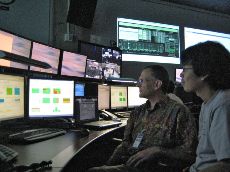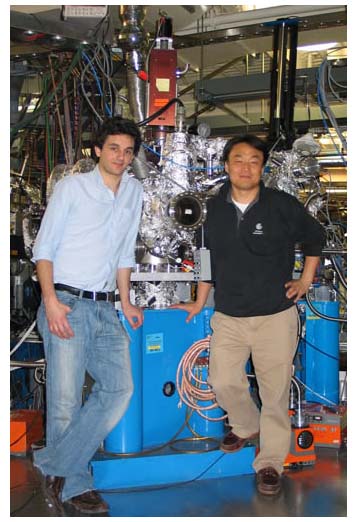The Department of Physics provides a dynamic and diverse environment for the training of both graduate and undergraduates students.

Physics Building
Our three core research areas of condensed matter, high energy physics and cosmology, together with smaller programs in nuclear physics, high energy astrophysics, complexity sciences, and physics education, provide exciting opportunities for motivated students who are interested in cutting-edge research. Our undergraduates go on to top graduate schools and desirable positions in industry. Our graduate students go on to prestigious postdoctoral and faculty positions, become laboratory scientists, or move to excellent industry placements.
The vitality of our research programs stems in part from out rapid recent growth; 24 of our 46 faculty have been hired since year 2000. Indeed, our cosmology group, now one of the leading centers in the world for cosmology, has grown in the past seven years from just one member to ten.

UC Davis Physicists at the Fermilab Remote Control Center for the Large Hadron Collider's CMS Experiment

UC Davis students studying Materials at the Advanced Light Source at nearby Lawrence Berkeley Lab
Faculty awards, including emeritus
- Fellow of the American Physical Society-Andreas Albrecht, Paul Brady, Steven Carlip, Ling-Lie Chau, Shirley Chiang, John Conway, Daniel Cox, Nicholas Curro, James Draper, Charles Fadley, Ching-Yao Fong, John Gunion, Nemanja Kaloper, Barry Klein, Lloyd Knox, Richard Lander, Kai Liu, Warren Pickett, David Pines, John Rundle, Sergey Savrasov, Richard Scalettar, Rajiv Singh, Robert Svoboda, John Terning, J. Anthony Tyson, Romona Vogt, Xiangdong Zhu, Gergely Zimanyi
- Fellow of the Institute of Physics-Andreas Albrecht, Steven Carlip, Charles Fadley, Ching-Yao Fong, Kai Liu, Barry Klein, Warren Pickett, Rajiv Singh
- Fellow, American Association for the Advancement of Science-Andreas Albrecht, Shirley Chiang, James Draper, Charles Fadley
- Fellow of the American Geophysical Union-John Rundle
- Fellow of the American Vacuum Society-Shirley Chiang, Charles Fadley
- Fellow of the Institute of Nanotechnology-Kai Liu
- Fellow of the Optical Society of America-Xiangdong Zhu
- Fellow of the Institute of Electrical and Electronics Engineers-Kai Liu
- Member of the American Philosophical Society-David Pines, Anthony Tyson
- Member of the National Academy of Sciences-David Pines, J. Anthony Tyson
Students benefit not just from interaction with the teaching and research faculty, but also from the numerous emeritus professors, adjunct faculty, lecturers, research physicists, and postdoctoral physicists within the department. In addition, they enjoy support and friendship from approximately 350 fellow students, including both graduate students and undergraduates majoring in physics and applied physics. Students have access to research facilities on campus and worldwide. Professors and students in our department are highly collaborative across many areas of physics, promoting new avenues for discovery.
Student Statistics
Graduate Program (2017-2018)
- Number of current doctoral students: 160
- Number of current master's students: 4
- Percentage of current students who are female: 23%
- Percentage of current students who are underrepresented minorities: 5%
Undergraduate Program (2016-2017)
- Number of undergraduate majors: 265
- Undergraduate degrees awarded (Sept.-June 2016-2017): 42
- Time to degree-freshmen admits: 4.5 years
- Time to degree-transfer admits: 2.8 years
- Total course enrollment for PHY and AST (Fall quarter 2016 thru Summer Session II 2017): 10,669 students
The department continues to grow in exciting ways. In 2015-2016, we completed searches for faculty as part of an initiative on physics and mathematics of the universe, which resulted in four new faculty in Physics and one in Mathematics. Since 2016 we have added four new faculty in condensed matter experiment and three in cosmology, as well as one in high energy particle physics. Our department's research in these areas addresses some of the most exciting and fundamental questions in science today: What are the most fundamental interactions of matter, and what is the source of mass? What is the nature and origin of the universe and how did it evolve from the Big Bang? What are the properties of complex microscopic systems, in uniquely controlled or novel quantum states? Can we predict how to make novel materials and can we use the spin of the electron to make electronic devices?
Faculty 2017-18
- Senate faculty headcount (Prof, Assoc Prof, Asst Prof, Sr Lecturer SOE): 50
- Senate faculty FTE: 49.25
- Number of Senate faculty who are women: 9 (18%)
- Number of Senate faculty who are non-Asian people of color: 2
- Emeritus faculty: 19
- Adjunct faculty: 3
- Research faculty and postdoctoral scholars: 45
- Continuing lecturer headcount: 1
- Temporary lecturer headcount (varies by quarter): 3
Our department has traditionally emphasized connections to the development of innovative technology; and indeed, graduates in all of our core disciplines have the materials science expertise, computational skills, and theoretical analysis skills that are much in demand in industry, particularly in Silicon Valley. Recent interdisciplinary initiatives, such as CSC, NEAT, and Universe@UCDavis, as well as the start of the LHC, will further increase the opportunities for physics graduate students to pursue interdisciplinary research.
Research expenditures for 2017-18 exceeded $7 million.
For more information about opportunities in research, please see Research Areas.

